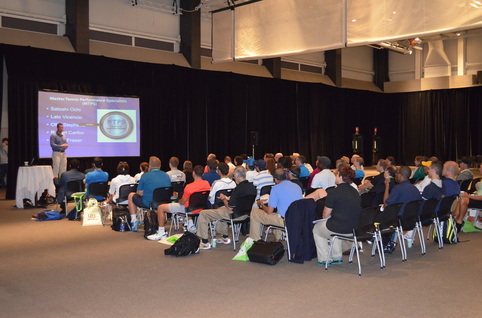Over the weekend of the 19th and 20th July 2014 both myself and Mike James attended the Society for Tennis Medicine and Science (STMS) and International Tennis Performance Association (iTPA) Tennis Medicine and Performance Conference at Life University, Marietta, Atlanta. With over 100 delegates attending the conference from a range of backgrounds including tennis coaching, strength and conditioning, sports medicine and other sport science disciplines the two day event provided the latest tennis research whilst delivering a host of practical sessions. With both Mike being a performance tennis coach and myself being a Certified Strength and Conditioning Specialist (CSCS), Certified Tennis Performance Specialist (CTPS), Master Tennis Performance Specialist (MTPS) alongside coaching tennis the majority of sessions we attended focused on the physical training and preparation of players; however, with our understanding of the holistic approach to developing tennis players it was of great interest to attend psychology, nutrition and medical presentations throughout the weekend.
The first session by one of the most respected tennis sport scientists, Dr. Mark Kovacs, gave an excellent explanation of the eight stages of the serve focusing on the technical aspects, physical components and injury reduction strategies. Particular points to mention were for coaches to be aware of hyperangulation of their athletes when preparing in the serve (where the humerus in time lags behind the scapular before accelerating up to strike the serve) and that when for example a right handed player serves they lands on their left leg countless times which may lead to an imbalance. It was suggested to consider that after a group of serves that a player completes a set of single leg squats on the non landing leg. Leading on from that it was a great pleasure to hear the editor of the NSCA journal Dr. Jeff Chandler discuss myths of training professional tennis players. This was an interactive session with the floor offering plenty of discussion. Areas focused on were strength training, physical testing, periodisation and tennis specific endurance training. There was an in depth discussion of when training junior tennis players to be aware of their chronological, biological and training age and ways in which to manage this.
There were a host of other fascinating presentations attended by myself and Mike James. Page Love delivered a session on nutrition focusing on recovery and reducing the potential risk of injury for tennis players. Much of the focus was on tart cherry juice and the antioxidant nature of this to reduce muscle soreness and aid recovery. Indeed this would be a very interesting research topic for anyone in tennis considering the benefits of tart cherry juice during intense match play and recovery. Ollie Stephens then considered the important factors when working as a team to develop competitive tennis players and Dr. Larry Lauer discussed bringing back players from injury. This lecture provided a great insight into the stages an athlete goes through when being injured, such as going through the grief stages and how a team can respond in a way to create a supportive, nurturing environment to help get the athlete back to full fitness. This included factors such as clear and transparent communication, education and listening to the athlete. Other excellent sessions discussed injury and illness data from the US Open for the past 15 years and the age eligibility rule and managing WTA players. Both gave a great insight to working with elite professionals.
Away from the presentations the forums provided delegates to ask questions related to tennis science and medicine questions with two themes. The first one focused on developing young healthy tennis athletes. Indeed the topics varied from ways in which to strength train, manage volume and nutrition such as supplementation. The second panel discussed working with elite full time tennis professionals. It was also a pleasure to hear Atlanta based ATP tennis professional Robby Ginepri give his opinions on how tennis has changed over the past decade since he began his career on the tour. There was great acknowledgement that sport science and medicine has a larger part now to play when developing players and this is due to the advancement of the game physically. Ginepri explained that within his academy sport science plays an important role with the use of physical conditioning and performance psychology and nutrition sessions. This gave me great confidence with me recently starting my own business (www.scienceintennis.com) which is a sport science business solely focusing on tennis.
Ultimately both Mike and I feel there were a number of take home messages for practitioners working in tennis to be aware off. First of all you have to know the game, be aware of the common areas of injury, the challenges both junior tennis and senior professional players face alongside understanding the uniqueness of how to train a tennis player. Secondly, every tennis player is different and knowing your athlete and allowing them to feedback to you and the team you work with is essential to develop a strong professional relationship and maximise their potential. Thirdly don't over complicate things, tennis is a difficult sport to plan and periodise for so use the most effective ways of training but keep things as simple as possible. It was clear that educating players, coaches and parents alongside communicating with and understanding the roles of practitioners who can help develop tennis players, reduce injury and enhance performance is essential, the goal of any of us working within tennis.
Over 11 Hours of Presentations from the 2014 Tennis Medicine & Performance Conference available for download at the iTPA Dartfish Channel
http://www.dartfish.tv/CollectionInfo.aspx?CR=p90378c98277






 RSS Feed
RSS Feed
